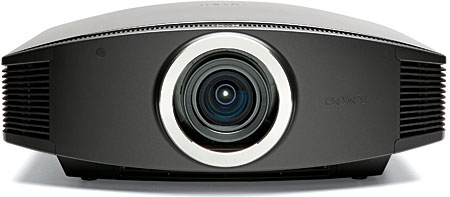Sony BRAVIA VPL-VW85 SXRD Projector
 Price: $8,000 At A Glance: Solid blacks • Accurate color • Unique adjustability • Color management system could be more effective • Superb resolution
Price: $8,000 At A Glance: Solid blacks • Accurate color • Unique adjustability • Color management system could be more effective • Superb resolution
Big Performance
The June 2009 issue of Home Theater featured a glowing report on Sony’s VPL-VW70 video projector. But as they say, time flies when you’re having fun. Building on its enviable past record in cutting-edge, high-value video projectors, Sony has just launched the VPL-VW70’s successor, the VPL-VW85.

Instead of a wild departure from its predecessor, the new model is a refinement. It’s just as impressive in most respects, but there’s at least one significant improvement: dramatically higher brightness.
Description
As home projectors go, the VPL-VW85 is a large, heavy beast, but its mass is softened by
a sleekly curved top that’s finished in black with metallic blue flecks. The operating controls are located behind a panel on the side. The inputs and power connections
are below this, deeply recessed below the overhanging chassis. With a tabletop setup, it’s nearly impossible to insert cables (particularly HDMI cables) into the inputs without lifting the
side of the projector, which then requires a small realignment. This is a minor nuisance if you change cables often, but it could be a major one if you mount the projector inverted against a ceiling with no clearance.
As with all of Sony’s high-end home theater projectors, the VPL-VW85 is an SXRD design. SXRD, which stands for Silicon X-tal Reflective Display, is Sony’s version of LCOS (Liquid Crystal on Silicon), a reflective variation on LCD technology. In a conventional LCD projector, the imaging chips are transmissive—that is, the light passes through them once on its way to the lens. With SXRD and LCOS, the light passes through the LCD panel, bounces off a reflective surface, and passes through the chip a second time before passing on to the lens. In a conventional LCD, the pixel-driving circuits must be routed in dead spaces between the pixels; in an LCOS design, they can hide behind the reflective surface, which allows the pixels to be positioned closer together. This maximizes the amount of picture area the imaging elements can cover.

The VPL-VW85 has three SXRD imaging chips, one for each color. There’s no moving color wheel and therefore no rainbow artifacts. To ensure that these three chips are in precise alignment, the projector’s controls let you tweak the position of the colors electronically, in fractions of a pixel. It can also perform these alterations over the entire screen simultaneously or in 144 individually adjustable zones.
The projector’s 1.6x zoom lens will fill a 100-inch-diagonal (87-inch-wide) 16:9 screen from distances ranging from (approximately) 10.7 to 15.9 feet. All of the lens adjustments (zoom, focus, and horizontal and vertical shift) are motorized, and you have to make all of your adjustments while you watch a special lens adjustment test pattern. You can’t make them while you watch an external source.
There are six different picture modes. You can adjust each of them manually and also set up a given mode differently for each input.
Sony’s Real Color Processing (RCP) feature provides color and hue (but not brightness) adjustments for each of the primary and secondary colors. In my opinion, RCP, which we’ve seen in other Sony displays, has always been too ergonomically confusing to be effective. I would welcome a more intuitive color management system—one that offers not only color and hue control for each color, but brightness as well.
- Log in or register to post comments





























































